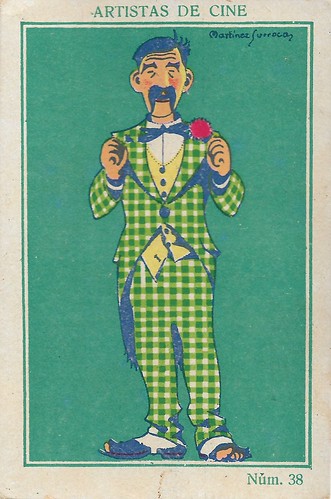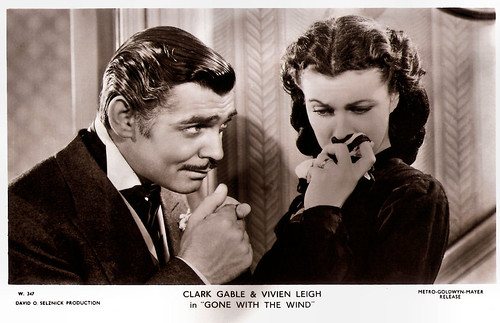Soup strainer. Lip rug. Face lace. Mouth mane. Call it what you want, but the moustache is a wonderful dapper accessory for a man in films. Though moustaches can easily cross the line from classy and refined to creepy and repulsive, at least you can count on the film world to get it right. The actors and film characters on the 15 postcards below all have epic, unique, and memorable 'staches', from the silly to the sublime.
![Max Linder]()
French postcard by Pathé Frères. Photo: Felix.
![Max Linder]()
French postcard by Pathé Frères. Photo: Felix.
![Max Linder]()
French postcard by Pathé Frères. Photo: Felix.
French comedian Max Linder (1883-1925), with his trademark silk hat, stick and moustache was an influential pioneer of the silent film. He was largely responsible for the creation of the classic style of silent slapstick comedy and he was the highest-paid entertainer of his day.
![Snub Pollard]()
Spanish collectors card by Chocolates Amatller, Barcelona, in the 'Artistas de cine' series, no. 38: Snub Pollard. Image: Martinez Surroca.
Australian-born comedian Snub Pollard (1889-1962) with his walrus moustache was one of the well-known faces of the Hal Roach company during the 1910s.
![Charlie Chaplin in The Kid (1921)]()
German postcard by Ross Verlag, no. 664/1. Photo: Hansaleih. Charlie Chaplin in The Kid (Charles Chaplin, 1921).
![Charlie Chaplin, Eddie Baker and Hank Mann in City Lights (1931)]()
German postcard by Ross Verlag, no. 129/5, 1930-1931. Photo: SF / United Artists. Charlie Chaplin, Eddie Baker, and Hank Mann in City Lights (Charles Chaplin, 1931).
![Charlie Chaplin]()
Dutch postcard. Sent by mail in the Netherlands in 1948. Photo: Charles Chaplin in The Great Dictator (1940).
Charles ‘Charlie’ Chaplin (1889-1977) was best-known as The Tramp with his toothbrush moustache, undersized bowler hat, and bamboo cane who struggled to survive while keeping his dignity in a world with great social injustice. At AZcentral, Barbara Vandenburgh put Chaplin at the top of her moustaches list: "Charlie Chaplin’s Tramp character sported a toothbrush mustache throughout many films, long predating the rise of fascism in Germany. But he put that funny little mustache to daring use in his first talking picture. Released before America had entered WWII, Chaplin plays both a Jewish barber and the dictator Hynkel, the Hitleresque, fascist ruler of fictional Tomania whom Chaplin devastates with humor and mockery."
![Norman Kerry in Merry-Go-Round (1923)]()
French postcard by Cinémagazine-Edition, no. 401. Photo: Roman Freulich. Norman Kerry in Merry-Go-Round (Rupert Julian, Erich von Stroheim, 1923). Norman Kerry's surname is misspelled on the card as Keery.
![Douglas Fairbanks sr.]()
German postcard by Ross Verlag Foreign, no. 3658/4, 1928-1929. Photo: United Artists. Douglas Fairbanks is wearing the outfit from Don Q, Son of Zorro (Donald Crisp, 1925).
![Adolphe Menjou in The Sorrows of Satan (1926)]()
German postcard by Ross Verlag, Berlin, no. 1810/1, 1927-1928. Photo: Fanamet. Adolphe Menjou in The Sorrows of Satan (D.W. Griffith, 1926). Suave and debonair American actor Adolphe Menjou (1890-1963) with his trademark waxy black moustache was one of Hollywood's most distinguished stars and one of America's 'Best Dressed Men'.
![Felix Bressart]()
Dutch postcard, no. 238. Photo: Remaco-Film. At the top right is a censorship stamp, necessary in the Netherlands for all film photos at the time. German stage and screen actor Felix Bressart (1892–1949) had to flee Germany after the Nazis seized to power. He continued his film career in Austria and later in the US, where he became a popular character actor for MGM.
![Groucho Marx and Margaret Dumont in A Night at the Opera (1935)]()
British 'double' postcard by Heroes Creative, London, no. HH 125. Photo: publicity still of Groucho Marx and Margaret Dumont in A Night at the Opera (Sam Wood, 1935). Caption: You Suck and I'll blow or we'll both be suckers. Collection: Daniël van der Aa. As with Charlie Chaplin, Groucho Marx’s calling card – along with waggling eyebrows and a cigar – was his fake moustache. The vaudeville-era greasepaint mustache was as outsized as the Marx Brothers’ comedy.
![Errol Flynn in The Adventures of Robin Hood (1938)]()
French postcard, no. 764. Photo: Warner Bros. Errol Flynn in The Adventures of Robin Hood (Michael Curtiz, William Keighley, 1938).
Australian born actor Errol Flynn (1909-1959) achieved fame in Hollywood with his suave, debonair, devil-may-care attitude. He was known for his romantic Swashbuckler roles in films like The Adventures of Robin Hood (1938), donning the feathered hat (atop his Prince Valiant haircut and paired with a dainty pencil-thin moustache) to cross swords with the villainous Prince John (Claude Rains) when he usurps the throne that rightfully belongs to Richard the Lionheart.
![Vivien Leigh and Clark Gable in Gone with the wind (1939)]()
British postcard in the Picturegoer Series, London, no. W. 347. Photo: David O'Selznick Production / Metro-Goldwyn-Mayer. Vivien Leigh and Clark Gable in Gone with the Wind (Victor Fleming, 1939). Clark Gable portrayed Rhett Butler in Gone with the Wind with a trim but bristly lip hair.
![Alain Delon]()
Romanian postcard by Casa Filmului Acin, no. 169. Alain Delon made four films wearing just a moustache: Le cercle rouge (1970); La veuve Couderc (1971); Le Gitan (1975); and Un amour de Swann (1984).
![Jean Rochefort]()
Romanian postcard by Casa Filmului Acin, no. 569. French actor Jean Rochefort (1930-2017) had a career spanning over five decades. About his moustache, the actor said in 1994: "At the age of 40, I played the Misanthrope, my fake moustache was always going, so I decided to grow my own. Then I kept it because when I take it off I feel like I don't have any pants".
![Jason King with Peter Wyngarde]()
Vintage card. French-born English actor Peter Wyngarde (1928-2018) played Jason King, a bestselling novelist turned sleuth, in two British television series: Department S (1969–1970) and Jason King (1971–1972). In Department S Jason was a dilettante dandy and author working as part of a team of investigators. King's had a smooth rich voice and a luxurious moustache, and his choice of fashion was named by Mike Myers as an inspiration for his popular character Austin Powers.
Sources: Barbara Vandenburgh (Azcentral), RTL (French), and Amy Boal (Ranker).

French postcard by Pathé Frères. Photo: Felix.

French postcard by Pathé Frères. Photo: Felix.

French postcard by Pathé Frères. Photo: Felix.
French comedian Max Linder (1883-1925), with his trademark silk hat, stick and moustache was an influential pioneer of the silent film. He was largely responsible for the creation of the classic style of silent slapstick comedy and he was the highest-paid entertainer of his day.

Spanish collectors card by Chocolates Amatller, Barcelona, in the 'Artistas de cine' series, no. 38: Snub Pollard. Image: Martinez Surroca.
Australian-born comedian Snub Pollard (1889-1962) with his walrus moustache was one of the well-known faces of the Hal Roach company during the 1910s.

German postcard by Ross Verlag, no. 664/1. Photo: Hansaleih. Charlie Chaplin in The Kid (Charles Chaplin, 1921).

German postcard by Ross Verlag, no. 129/5, 1930-1931. Photo: SF / United Artists. Charlie Chaplin, Eddie Baker, and Hank Mann in City Lights (Charles Chaplin, 1931).

Dutch postcard. Sent by mail in the Netherlands in 1948. Photo: Charles Chaplin in The Great Dictator (1940).
Charles ‘Charlie’ Chaplin (1889-1977) was best-known as The Tramp with his toothbrush moustache, undersized bowler hat, and bamboo cane who struggled to survive while keeping his dignity in a world with great social injustice. At AZcentral, Barbara Vandenburgh put Chaplin at the top of her moustaches list: "Charlie Chaplin’s Tramp character sported a toothbrush mustache throughout many films, long predating the rise of fascism in Germany. But he put that funny little mustache to daring use in his first talking picture. Released before America had entered WWII, Chaplin plays both a Jewish barber and the dictator Hynkel, the Hitleresque, fascist ruler of fictional Tomania whom Chaplin devastates with humor and mockery."

French postcard by Cinémagazine-Edition, no. 401. Photo: Roman Freulich. Norman Kerry in Merry-Go-Round (Rupert Julian, Erich von Stroheim, 1923). Norman Kerry's surname is misspelled on the card as Keery.

German postcard by Ross Verlag Foreign, no. 3658/4, 1928-1929. Photo: United Artists. Douglas Fairbanks is wearing the outfit from Don Q, Son of Zorro (Donald Crisp, 1925).

German postcard by Ross Verlag, Berlin, no. 1810/1, 1927-1928. Photo: Fanamet. Adolphe Menjou in The Sorrows of Satan (D.W. Griffith, 1926). Suave and debonair American actor Adolphe Menjou (1890-1963) with his trademark waxy black moustache was one of Hollywood's most distinguished stars and one of America's 'Best Dressed Men'.

Dutch postcard, no. 238. Photo: Remaco-Film. At the top right is a censorship stamp, necessary in the Netherlands for all film photos at the time. German stage and screen actor Felix Bressart (1892–1949) had to flee Germany after the Nazis seized to power. He continued his film career in Austria and later in the US, where he became a popular character actor for MGM.

British 'double' postcard by Heroes Creative, London, no. HH 125. Photo: publicity still of Groucho Marx and Margaret Dumont in A Night at the Opera (Sam Wood, 1935). Caption: You Suck and I'll blow or we'll both be suckers. Collection: Daniël van der Aa. As with Charlie Chaplin, Groucho Marx’s calling card – along with waggling eyebrows and a cigar – was his fake moustache. The vaudeville-era greasepaint mustache was as outsized as the Marx Brothers’ comedy.

French postcard, no. 764. Photo: Warner Bros. Errol Flynn in The Adventures of Robin Hood (Michael Curtiz, William Keighley, 1938).
Australian born actor Errol Flynn (1909-1959) achieved fame in Hollywood with his suave, debonair, devil-may-care attitude. He was known for his romantic Swashbuckler roles in films like The Adventures of Robin Hood (1938), donning the feathered hat (atop his Prince Valiant haircut and paired with a dainty pencil-thin moustache) to cross swords with the villainous Prince John (Claude Rains) when he usurps the throne that rightfully belongs to Richard the Lionheart.

British postcard in the Picturegoer Series, London, no. W. 347. Photo: David O'Selznick Production / Metro-Goldwyn-Mayer. Vivien Leigh and Clark Gable in Gone with the Wind (Victor Fleming, 1939). Clark Gable portrayed Rhett Butler in Gone with the Wind with a trim but bristly lip hair.

Romanian postcard by Casa Filmului Acin, no. 169. Alain Delon made four films wearing just a moustache: Le cercle rouge (1970); La veuve Couderc (1971); Le Gitan (1975); and Un amour de Swann (1984).

Romanian postcard by Casa Filmului Acin, no. 569. French actor Jean Rochefort (1930-2017) had a career spanning over five decades. About his moustache, the actor said in 1994: "At the age of 40, I played the Misanthrope, my fake moustache was always going, so I decided to grow my own. Then I kept it because when I take it off I feel like I don't have any pants".

Vintage card. French-born English actor Peter Wyngarde (1928-2018) played Jason King, a bestselling novelist turned sleuth, in two British television series: Department S (1969–1970) and Jason King (1971–1972). In Department S Jason was a dilettante dandy and author working as part of a team of investigators. King's had a smooth rich voice and a luxurious moustache, and his choice of fashion was named by Mike Myers as an inspiration for his popular character Austin Powers.
Sources: Barbara Vandenburgh (Azcentral), RTL (French), and Amy Boal (Ranker).